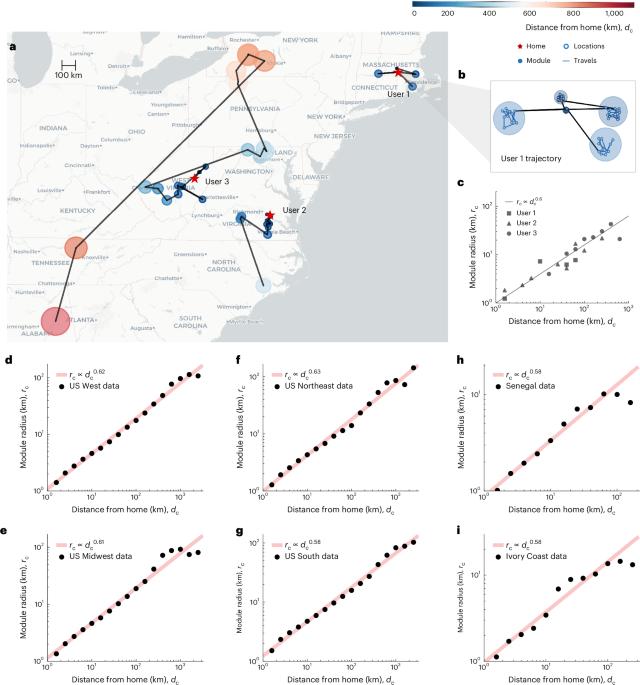Universal expansion of human mobility across urban scales
引用次数: 0
Abstract
Human mobility is a fundamental process underpinning socioeconomic life and urban structure. Classic theories, such as egocentric activity spaces and central place theory, provide crucial insights into specific facets of movement, including home-centricity and hierarchical spatial organization. However, identifying universal characteristics or an underlying principle that quantitatively links these disparate perspectives has remained a challenge. Here we reveal such a connection by analyzing the spatial structure of individual daily mobility trajectories using network-based modules. We discover a universal scaling law: the spatial extent (radius) of these mobility modules expands sublinearly with increasing distance from home, a pattern consistent across three orders of magnitude. Furthermore, we demonstrate that these modules precisely map onto the nested hierarchy of urban systems, corresponding to local, city-level and regional scales as distance from home increases. These findings deepen our understanding of human mobility dynamics and demonstrate the profound connection between classical urban theory, human geography and mobility studies. Urban space forms nested hierarchies: neighborhoods are embedded within cities, which in turn are part of larger regions. This study finds that as individuals travel farther from home, they explore decreasingly larger areas around their new locations.

人口流动在城市范围内的普遍扩张
人口流动是支撑社会经济生活和城市结构的基本过程。经典理论,如以自我为中心的活动空间和中心地理论,为运动的具体方面提供了重要的见解,包括以家庭为中心和分层空间组织。然而,确定普遍特征或在数量上联系这些不同观点的基本原则仍然是一项挑战。在这里,我们通过使用基于网络的模块分析个人日常移动轨迹的空间结构来揭示这种联系。我们发现了一个普遍的尺度规律:这些移动模块的空间范围(半径)随着离家距离的增加而次线性地扩展,这种模式在三个数量级上是一致的。此外,我们还证明,随着离家距离的增加,这些模块精确地映射到城市系统的嵌套层次结构上,对应于地方、城市级和区域尺度。这些发现加深了我们对人类流动性动态的理解,并证明了经典城市理论、人文地理学和流动性研究之间的深刻联系。城市空间形成嵌套的层次结构:社区嵌入城市中,而城市又是更大区域的一部分。这项研究发现,随着人们离家越来越远,他们在新地点周围探索的区域越来越大。
本文章由计算机程序翻译,如有差异,请以英文原文为准。
求助全文
约1分钟内获得全文
求助全文

 求助内容:
求助内容: 应助结果提醒方式:
应助结果提醒方式:


